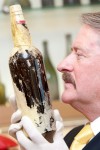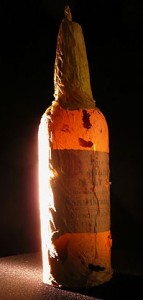Last summer, researchers from the Canterbury Museum in Christchurch, New Zealand thawed a crate of whisky found frozen solid under the floorboards of explorer Ernest Shackleton’s hut on Ross Island, Antarctica, in 2006. Whisky experts were all agog over the prospect of being able to analyze these spirits purchased for the expedition in 1907 because the original recipe for this brand, Mackinlay’s Rare Old Highland Malt Whisky, was long since lost. The bottles had been preserved in the deepest of deep freezes for a century and thus might provide all kinds of information about historical blends and distillation methods that you can’t get from whisky of the same age but that has lived a more active life.
 In January of this year, Richard Paterson and Dr. Vijay Mallya, respectively the master blender and owner of Whyte & Mackay, the company that owns the former Mackinlay’s distillery, flew to New Zealand on a private jet, picked up three bottles of Shackleton’s whisky then flew back with them to Scotland on the private jet. The cargo hold of a commercial plane would not have been able to provide the proper conditions for the safety and conservation of these precious, rare bottles, and obviously there are more than 3 ounces of liquid in the bottles, so they couldn’t fly in the passenger cabin either. Mallya volunteered his private plane for the task.
In January of this year, Richard Paterson and Dr. Vijay Mallya, respectively the master blender and owner of Whyte & Mackay, the company that owns the former Mackinlay’s distillery, flew to New Zealand on a private jet, picked up three bottles of Shackleton’s whisky then flew back with them to Scotland on the private jet. The cargo hold of a commercial plane would not have been able to provide the proper conditions for the safety and conservation of these precious, rare bottles, and obviously there are more than 3 ounces of liquid in the bottles, so they couldn’t fly in the passenger cabin either. Mallya volunteered his private plane for the task.
Paterson literally handcuffed himself to the protective cases the bottles were kept in for the duration of the voyage. He only detached himself from them under duress when customs made him. As a master blender and a nose, Paterson has an emotional bond to these bottles from a bygone era and the mysterious blend they contain. He’s the one who got to sample the whisky as part of the analytical process. The only other person allowed to taste it was whisky writer Dave Broom.
Here he is being adorably passionate about the whisky in a video from when it first arrived in Scotland. You can see the safety crates and the handcuffs in it:
[youtube=http://www.youtube.com/watch?v=KK2qQcgkM00&feature=player_embedded&w=430]
After that video was filmed, the bottles were taken to Whyte & Mackay’s laboratories in Invergordon where samples were extracted from each bottle by a syringe inserted through the stopper. Eight weeks of chemical and palate analysis ensued. The bottles were not opened or tampered with in any way, and they will be returned to the Antarctic Heritage Trust to be preserved along with their unsampled brothers.
Now Whyte & Mackay have announced the results of their study and their recreation of a replica of the Shackleton whisky. In two to eight weeks, 50,000 bottles of the replica whisky will be sold, starting in the UK then on to mainland Europe, the US, Australia and New Zealand.
Paterson expected the whisky to have a heavy, peaty flavor, which was the fashion at the time. Instead, according to his tasting notes, he discovered a Scotch with “delicate aromas of crushed apple, pear and fresh pineapple. It has a whisper of marmalade, cinnamon and a tease of smoke, ginger and muscovado sugar.”
[Rob Bruce, Whyte & Mackay’s head of global public relations] wouldn’t say much about the process Paterson used to create the replica.
“He used existing single malts, including liquid from the original Mackinlays distillery,” Bruce wrote in an email, referring to the company that made Shackleton’s stash. “We are not revealing any more than that at this stage.”[…]
Paterson’s tests revealed that the forsaken whisky has a 47.3 percent alcohol content, which is high. He believes this was to help prevent the liquid from freezing. The result, he said in his notes, is that it “gives plenty of impact, but in a mild and warming way. It has whispers of gentle bonfire smoke slowly giving way to spicy rich toffee, treacle and pecan nuts.”
The bottles will cost about $160 each, and 5% of the proceeds will be donated to the Antarctic Heritage Trust. If, as expected, the full run sells, the Trust will receive almost $400,000.
You can hear Dave Broom’s glowing review in this interview with Radio New Zealand. I’m not a whisky person but I have to admit it sounds delicious (although of course I wouldn’t care at all if it hadn’t come from Ernest Shackelton’s ice cellar).

